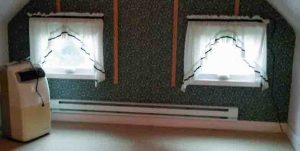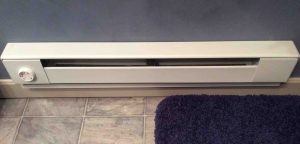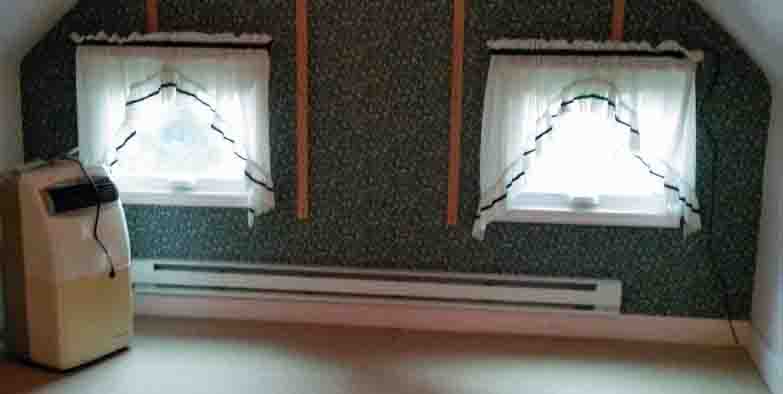We’ve dealt with the problem of electric baseboard heater noise for a decade now in our second floor bedrooms. This piece describes our experiences that show How to fix electric baseboard heater noise.

Baseboard heaters are great for adding to the home’s base heating (the furnace). They can fix a room always being cold. But unless you’ve spent extra money for quiet hydronic heaters, common electric baseboard heaters tend to be noisy. They ping, pang, pop, tap, tick, squeak, squeal, hum, click, whine, bang, zing, and ring, when ON. These sounds happen as the parts in the heater change size and vibrate while warming. Then, when the thermostat shuts off, the heaters make similar noises as the cool.
Here are a couple of the tricks we’ve tried with success. These worked well on Dimplex and Farenheat heaters, to fix or at least, reduce the electric baseboard heater noise.
How to Fix Electric Baseboard Heater Noise
Grease the Baseboard Heater
Apply a high temp silicone based grease to all brackets and joints. Put it any places where different pieces of metal meet and could rub and bind. Since these joints can get quite hot during use, apply a thick, non drying grease. This lube should take these high temps without catching fire or breaking down. We’ve used the WD-40 Specialist Water Resistant Silicone Lubricant, and various brands of white lithium grease with good results. But no grease keeps electric baseboard heaters quiet without periodic re-application. We’ve “re lubed” the heaters every other year, to keep the noise down.
Reinforce all Brackets and Joints Reduces Electric Baseboard Heater Noise
Hoping to reduce the need for these lubes, we also tightened those brackets in our heaters. These hold the element This heating element looks like a long, thin bar. It sports many heat fins too.
During warming and cooing, we found that noise occurred where these brackets hold the element. So we drilled a single hole in each bracket where, it meets the cabinet. Then, we drove sheet metal screws through those holes. We made eight holes for our eight foot 2500 watt heaters. Use short, stubby, thick-threaded screws here. This step best lowered the electric baseboard heater noise. While they still click and pop some, our heaters do so far less than before. The squeaks and squeals completely disappeared too.
How to Fix Electric Baseboard Heater Noise: Tighten All Screws
Check the screws that hold the heater to the wall as well. Be sure to drive the screws right into the studs. Larger wall anchors provide good support too if you can’t get to the studs. At any rate, you want a more solid, less vibration transmitting backing for the electric baseboard heater. This reduces the “sound board” effect of the drywall or plaster behind the heater.
Secure the Heating Element
Electric baseboard heaters also hum while operating; especially the higher power home units like ours. The more current they draw, the more likely they are to hum and buzz. This problem wasn’t simple to fix like the squeaks, pings, and pops. But we still managed to lower the hum. How? We secured the heating element in those brackets. This reduces the buzzing that results when a loosely held heating element vibrates within the standoff brackets. The bracket should clamp the element tightly. Try bending the bracket for this snugger fit. But do not flex the bracket too many times; lest it snap apart.
Choose a Good Thermostat
Thermostats can cause electric baseboard heater noise too. Choosing a decent thermostat thus, is key. That choice is critical in fact, for lowest noise heaters. Now that triac based thermostats are so common, you may see this source of heater noise. These devices use the same sort of triac for switching as light dimmers. Anyone who’s ever played with a light dimmer knows this. Both the light and dimmer can buzz loudly when the dimmer at the brightest (fully on) setting.
Well, also, a poorly built thermostat adds noise too. How? It may not always turn the triac fully on during each AC power sine wave cycle. This distorts the power wave form going into the heater, and creates jagged edges. This non round edges thus, lead to louder buzzing in your heater and create much electric baseboard heater noise. This switching hash in the line can make radio and TV interference (RFI) too. So, replacing your thermostat may solve these buzzing problems.
To test if the thermostat is causing this electric baseboard heater noise, try bypassing it temporarily. E.g. Apply jumper cords across its switched terminals. If the buzz goes away then the thermostat is your culprit. If you replace the thermostat though, use caution when selecting an old style metal switched model. These contain physically operated micro switches, that click when turning on and off. Thermostats like these can therefore add their own brand of distracting noises to the base board heating noises.

Replace the Electric Baseboard Heater, the Best Solution for How to Fix Electric Baseboard Heater Noise
Sadly, non-hydronic heaters are usually louder. So, they may not work well in bedrooms or areas needing quiet. The hydronic liquids in these better heaters surround the element, which the designers suspend inside a copper pipe. This lowers humming quite well. Plus, they keep the element cooler during operation, for longer life.
In hydronic heaters thus, the heating is more constant. Hydronic heaters are slower to warm up, and slower to cool down. That is, you don’t have the big temp swings that you get in cheaper heaters. So there’s less expansion and contraction of the element, the brackets, screws, the case, and other parts. As a result, you have less noise from hydronic units. With these heaters, you indeed get what you pay for.
We may change out our low cost 220-volt heaters with hydronic models. In fact, there are lots of very quiet heating units of this type sold today. We see them running in homes of friends and at school. But until you’re ready to upgrade to these top-notch heaters, try the steps above. They have quieted our heaters enough to put up with. When they’re still too noisy though, we just add a white noise machine or fan nearby. These devices effectively mask electric baseboard heater noise.
